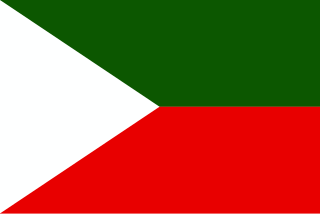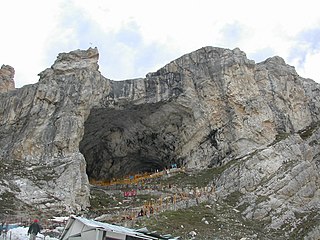Related Research Articles

Jammu and Kashmir was a region formerly administered by India as a state from 1952 to 2019, constituting the southern and southeastern portion of the larger Kashmir region, which has been the subject of a dispute between India, Pakistan and China since the mid-20th century. The underlying region of this state were parts of the former princely state of Jammu and Kashmir, whose western districts, now known as Azad Kashmir, and northern territories, now known as Gilgit-Baltistan, are administered by Pakistan. The Aksai Chin region in the east, bordering Tibet, has been under Chinese control since 1962.

The insurgency in Jammu and Kashmir, also known as the Kashmir insurgency, is an ongoing separatist militant insurgency against the Indian administration in Jammu and Kashmir, a territory constituting the southwestern portion of the larger geographical region of Kashmir, which has been the subject of a territorial dispute between India and Pakistan since 1947.

The Jammu Kashmir Liberation Front (JKLF) is a formerly armed, political separatist organisation active in both the Indian-administered and Pakistani-administered territories of Kashmir. It was founded by Amanullah Khan, with Maqbool Bhat also credited as a co-founder. Originally a militant wing of the Azad Kashmir Plebiscite Front, the organization officially changed its name to the Jammu Kashmir Liberation Front in Birmingham, England on 29 May 1977; from then until 1994 it was an active Kashmiri militant organization. The JKLF first established branches in several cities and towns of the United Kingdom and other countries in Europe, as well as in the United States and across the Middle East. In 1982, it established a branch in the Pakistani-administered territory of Azad Jammu and Kashmir, and by 1987, it had established a branch in the Indian-administered Kashmir Valley.

Doda district is an administrative district of the Jammu division of Indian-administered Jammu and Kashmir in the disputed Kashmir region.

The Amarnath Temple is a Hindu shrine located in the Pahalgam tehsil of the Anantnag district of Jammu and Kashmir, India. A cave situated at an altitude of 3,888 m (12,756 ft), about 168 km from Anantnag city, the district headquarters, 141 km (88 mi) from Srinagar, the summer capital of Jammu and Kashmir, reached through either Sonamarg or Pahalgam. It is an important shrine of Hinduism. The cave, located in Sind Valley, is surrounded by glaciers, snowy mountains and is covered with snow most of the year, except for a short period in the summer, when it is open to pilgrims. In 1989, pilgrims numbered between 12,000 and 30,000. In 2011, the numbers reached a peak, crossing 6.3 lakh (630,000) pilgrims. In 2018 pilgrims numbered 2.85 lakh (285,000). The annual pilgrimage varies between 20 and 60 days.

The Kashmir conflict is a territorial conflict over the Kashmir region, primarily between India and Pakistan, and also between China and India in the northeastern portion of the region. The conflict started after the partition of India in 1947 as both India and Pakistan claimed the entirety of the former princely state of Jammu and Kashmir. It is a dispute over the region that escalated into three wars between India and Pakistan and several other armed skirmishes. India controls approximately 55% of the land area of the region that includes Jammu, the Kashmir Valley, most of Ladakh, the Siachen Glacier, and 70% of its population; Pakistan controls approximately 30% of the land area that includes Azad Kashmir and Gilgit-Baltistan; and China controls the remaining 15% of the land area that includes the Aksai Chin region, the mostly uninhabited Trans-Karakoram Tract, and part of the Demchok sector.
The following is a timeline of the Kashmir conflict, a territorial conflict between India, Pakistan and, to a lesser degree, China. India and Pakistan have been involved in four wars and several border skirmishes over the issue.

The 2000 Amarnath pilgrimage attack on 1 and 2 August was the massacre of at least 89 to 105 people and injury to at least 62 people, in at least five different coordinated attacks by Islamist militants in Anantnag district and Doda district of Indian administered Kashmir.
1997 Sangrampora massacre was the killing of seven Kashmiri Pandit villagers in Sangrampora village of Budgam district of Jammu and Kashmir on 21 March 1997, by unknown gunmen. While militants have been thought behind the killings, police closed the case as untraced.
Human rights abuses in Jammu and Kashmir range from mass killings, enforced disappearances, torture, rape and sexual abuse to political repression and suppression of freedom of speech. The Indian Army, Central Reserve Police Force (CRPF), and Border Security Personnel (BSF) have been accused of committing severe human rights abuses against Kashmiri civilians. According to Seema Kazi, militant groups have also been held responsible for similar crimes, but the vast majority of abuses have been perpetrated by the armed forces of the Indian government.
Human rights abuses in Kashmir have been perpetrated by various belligerents in the territories controlled by both India and Pakistan since the two countries' conflict over the region began with their first war in 1947–1948, shortly after the partition of British India. The organized breaches of fundamental human rights in Kashmir are tied to the contested territorial status of the region, over which India and Pakistan have fought multiple wars. More specifically, the issue pertains to abuses committed in Indian-administered Kashmir and in Pakistani-administered Kashmir.

The Exodus of Kashmiri Hindus, or Pandits, is their early-1990 migration, or flight, from the Muslim-majority Kashmir valley in Indian-administered Kashmir following rising violence in an insurgency. Of a total Pandit population of 120,000–140,000 some 90,000–100,000 left the valley or felt compelled to leave by the middle of 1990, by which time about 30–80 of them are said to have been killed by militants.

Burhan Wani was a commander of Hizbul Mujahideen, an Islamist militant organization and insurgent group of the Kashmir conflict. He had become a popular figure amongst the local Kashmiri populace, having done so primarily through a strong social media presence, and was responsible for moulding the insurgency in Jammu and Kashmir into a youth-oriented movement. Wani was a militant leader and had reportedly recruited numerous foot-soldiers through his personal efforts.

After the Partition of India, during October–November 1947 in the Jammu region of the princely state of Jammu and Kashmir, many Muslims were massacred and others driven away to West Punjab. The killings were carried out by extremist Hindus and Sikhs, aided and abetted by the forces of Maharaja Hari Singh. The activists of the Rashtriya Swayamsevak Sangh (RSS) played a key role in planning and executing the riots. An estimated 20,000–100,000 Muslims were massacred. Subsequently, many non-Muslims were massacred by Pakistani tribesmen, in the Mirpur region of today's Pakistani administered Kashmir, and also in the Rajouri area of Jammu division.
The Kashmir conflict has been beset by large scale usage of sexual violence by multiple belligerents since its inception.
On 10 July 2017, the first Monday of the month of Shraavana, 8 Hindu civilian pilgrims on the way from Amarnath Temple in Kashmir Valley, in the Indian state of Jammu and Kashmir, were killed in a terror attack. The pilgrims mostly belonged to the Indian state of Gujarat. Eight people were killed and at least 18 people were injured in the attack.
On 20 July 2001, in the month of Shraavana, 13 people were killed and 15 other injured in a terror attack on a pilgrim night camp at Sheshnag Lake near the Amarnath Temple glacial cave shrine in Kashmir Valley in the Indian state of Jammu and Kashmir, in two explosions and firing by militants. In a pre-dawn attack, terrorists penetrated several layers of security cordon and exploded two improvised explosive devices (lEDs), casualties included 8 Hindu civilian pilgrims entailing 2 women, and 3 Muslim civilians and 2 security personnel.
On 30 July and 6 August 2002, in the month of Shraavana, 11 people were killed and 30 injured in a terror attack by Islamic extremists from Lashkar-e-Taiba's front group of al-Mansuriyan, on Nunwan base camp at Pahalgam of the Amarnath Hindu pilgrimage (Yatra) to Amarnath Temple glacial cave shrine in Kashmir Valley in the Indian state of Jammu and Kashmir. In the spate of attacks on Yatra in the third consecutive year, 2 pilgrims were killed and 3 injured on 30 July when terrorists threw grenades at a civilian taxi of pilgrims in Srinagar. Further, 9 people were killed and 27 injured on 6 August by Lashkar-e-Taiba (LeT) terrorists' hail of bullets at Nunwan base camp at Pahalgam.
Women's rights in Jammu and Kashmir is a major issue. Belonging to a patriarchal society, they have had to fight inequality and routine discrimination. Since the onset of insurgency in 1988, rape has been leveraged as a popular 'weapon of war' by Indian security forces. Separatist militants have also committed rapes, which remain under-researched but are not comparable in scale to that of the Indian state forces. Women's rights in Kashmir Valley has major issues as there is harassment of young muslim women participating in sports activities, demands of dowry after marriage, domestic violence incidents, acid attacks on women, and men being generally taken in a higher regard than women. Many small organisations have been formed to struggle for women's rights in Jammu and Kashmir.
References
- 1 2 3 4 5 6 7 8 9 Shubh Mathur (2016). The Human Toll of the Kashmir Conflict: Grief and Courage in a South Asian Borderland (1st ed.). Palgrave Macmillan US. p. 33. ISBN 978-1-349-57590-9.
- ↑ Aashaq Hussain Bhat, Dr.R.Moorthy (2016). "Impact of Security Provisions in Kashmir" (PDF). International Journal of Social Impact. 1, 4: 6–10. ISBN 978-1-365-47905-2. ISSN 2455-670X.